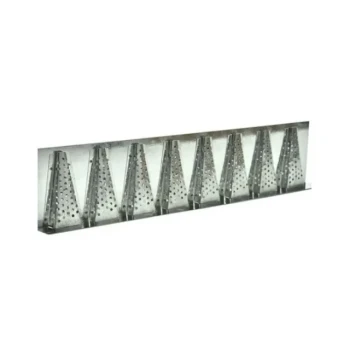The most reliable way to protect your honey from ants is not by trying to mask its scent, but by creating an impassable physical barrier. Simply place your honey jar or container inside a shallow dish of water to create a "moat" that ants cannot cross.
The core issue isn't ants smelling the honey inside a sealed jar; it's their attraction to the microscopic, sticky residue on the outside. The ultimate solution is to either create a physical barrier they cannot breach or maintain perfect cleanliness.

Understanding the True Attractant
Before setting up a defense, it's critical to understand what you're fighting. The problem is simpler than you might think.
It's Not the Scent, It's the Drips
Ants are foragers looking for the easiest possible food source. A sealed jar of honey is a fortress.
A tiny, sticky drip of honey on the side of that jar, however, is an open invitation. This easily accessible residue is almost always the initial attractant.
The Power of the Ant Trail
Once a single scout ant finds this food source, it returns to the nest, leaving a chemical pheromone trail. This trail acts as a superhighway, guiding dozens or hundreds of other ants directly to the target.
The Most Effective Solution: The Water Moat
This method is simple, inexpensive, and nearly 100% effective because it works by creating a barrier ants physically cannot cross.
How to Create the Moat
Find a small bowl or shallow dish that is wider than the base of your honey container.
Place the honey jar in the center of the dish. Pour about a half-inch of water into the dish, creating a ring of water around the honey.
Why This Method is Foolproof
Ants cannot swim across the water. The moat creates an impassable barrier that completely isolates your honey from their foraging paths, regardless of any sticky residue.
Simple Maintenance
You will need to change the water every few days to prevent it from evaporating or becoming stagnant. This small step ensures your defense remains active.
An Alternative Strategy: Meticulous Cleaning
If you prefer not to use a water moat, your only other reliable option is to remove the attractant entirely through disciplined cleaning.
The Wipe-Down Rule
After every single use, you must wipe down the entire honey container with a damp cloth. Pay special attention to the lid, threads, and any area where honey might have dripped.
Why Cleanliness Works
This method follows the most basic principle of pest control: remove the food source. If there is no sticky residue for the scout ant to find, it will never lay down a pheromone trail for others to follow.
Common Pitfalls and Ineffective Methods
Many folk remedies are shared that fail to address the core problem and will ultimately lead to frustration.
The Foil Fallacy
Wrapping a honey jar in aluminum foil is an unreliable strategy. Ants are persistent and can find microscopic gaps. More importantly, if any sticky residue gets on the outside of the foil, you have simply moved the problem.
Scent Deterrents
While some strong smells like cinnamon, cloves, or vinegar can disrupt ant trails temporarily, they do not create a physical barrier. A determined ant colony will eventually find a way around a scent-based deterrent.
Making the Right Choice for Your Goal
Your choice of strategy depends on your tolerance for risk and your daily habits.
- If your primary focus is a 100% guaranteed, set-it-and-forget-it solution: The water moat is the undisputed best method.
- If your primary focus is a minimalist approach and you are highly diligent: The meticulous wipe-down method will work, but it requires consistency.
- If you are dealing with a major infestation: Use the water moat for immediate protection while you take broader steps to eliminate the ant colony from your home.
By understanding the true nature of the problem, you can implement a simple and effective defense.
Summary Table:
| Method | How It Works | Best For |
|---|---|---|
| Water Moat | Creates a physical barrier ants cannot cross. | Guaranteed, set-and-forget protection. |
| Meticulous Cleaning | Removes the sticky residue that attracts ants. | Those who are highly diligent after each use. |
Protect your harvest and your investment. As a commercial beekeeper or distributor, a single ant infestation can compromise product quality and lead to significant losses. HONESTBEE supplies durable, high-quality beekeeping supplies and equipment designed for large-scale operations. From secure honey storage containers to other essential tools, our wholesale-focused solutions help you maintain a clean, efficient, and pest-resistant apiary. Contact our experts today to discuss your commercial needs and ensure your honey stays protected.
Visual Guide

Related Products
- Mesh Ventilated 3 Layer Goatskin Beekeepers Gloves for Beekeeping
- Beekeeping Gloves Goatskin Leather with Long Cotton Sleeve for Beekeepers
- 8-Cone Galvanized Steel Bee Robber Guard
- Metal Queen Bee Excluder for Beekeeping
- Professional Plastic Queen Excluder for Modern Beekeeping
People Also Ask
- What is the recommendation for beginning beekeepers regarding gloves? Build Confidence and Safety
- Why is it important to have gloves available even if not always worn? Essential Risk Management for Beekeepers
- What is the role of gloves in beekeeping, especially for beginners? Build Confidence & Safety
- What factors should be considered when selecting beekeeping gloves? Balance Protection and Dexterity
- Do beekeeping gloves completely prevent stings? Maximize Your Hive Safety and Confidence



















